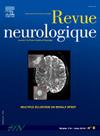Remote neurological evaluation reliably identifies patients eligible to endovascular therapy while non-eligible to intravenous thrombolysis
IF 2.8
4区 医学
Q2 CLINICAL NEUROLOGY
引用次数: 0
Abstract
Introduction/background
Early identification of suspected stroke patients who might be eligible for a reperfusion strategy is a daily challenge in the management of patient referrals. The aim of this study was to evaluate the performance of a remote medical assessment in identifying patients eligible for endovascular therapy (EVT) while not eligible for intravenous thrombolysis (IVT), compared with a decision based on bedside clinico-radiological data.
Methods
Patients admitted to the emergency department for acute neurological symptoms lasting for less than 24 h were prospectively included. Assessment of the clinical severity and medical history was performed simultaneously by two vascular neurologists (VNs), one remotely using a mobile telemedicine solution (NOMADEEC), the other at the bedside. RACE score was calculated from the NIHSS score. At the end of the evaluation, both VNs quoted their treatment convictions (IVT/EVT). Final therapeutic decision following brain and vascular imaging was recorded and compared to remote and bedside predictions. The performances of three different conditions were evaluated: complete medical evaluation (NIHSS + medical history), NIHSS score alone, and RACE score alone. Remote and bedside performances were also compared. Diagnostic accuracy parameters (sensitivity, specificity, positive and negative predictive values) of each condition were estimated, along with their two-sided 95% binomial confidence intervals.
Results
Out of 215 enrolled patients, 186 had a complete evaluation, 91 (54.3%) were diagnosed with an ischemic stroke or transient ischemic attack and 46 (24.7%) had an intracranial occlusion. Considering the three conditions evaluated remotely, RACE score-based decision provided the best sensitivity 54.6% [95% CI 23.4; 83.2]/specificity 80.6% [73.9; 86.2] combination. However, the complete medical evaluation had the best specificity (88.6% [82.9; 92.9] compared to RACE scores alone (P = 0.038). Remote and bedside performances did not differ (κ = 0.68 [0.59; 0.77]).
Discussion/conclusion
This real-life study performed in the setting of emergency demonstrates that remote medical evaluations including recording of extensive medical information and NIHSS examination to address patient's eligibility to revascularization treatment is swiftly feasible and is as effective as bedside prediction to EVT and/or IVT. Remote standardized medical evaluation might improve the decision of patients’ primary orientation and avoid overcrowding of comprehensive stroke centres.
远程神经评估能可靠地识别出符合血管内治疗条件但不符合静脉溶栓条件的患者。
导言/背景:早期识别可能符合再灌注策略的疑似卒中患者是患者转诊管理中的一项日常挑战。本研究旨在评估远程医疗评估在识别符合血管内治疗(EVT)条件但不符合静脉溶栓(IVT)条件的患者方面的性能,并与基于床旁临床放射学数据的决策进行比较:方法:前瞻性地纳入因急性神经症状持续时间少于 24 小时而入住急诊科的患者。临床严重程度和病史评估由两名血管神经学家(VN)同时进行,其中一名使用移动远程医疗解决方案(NOMADEEC)进行远程评估,另一名在床边进行评估。根据 NIHSS 评分计算 RACE 评分。在评估结束时,两位 VN 都会提出他们的治疗意见(IVT/EVT)。记录脑部和血管成像后的最终治疗决定,并与远程和床旁预测进行比较。评估了三种不同情况下的表现:完整的医学评估(NIHSS+病史)、单独的 NIHSS 评分和单独的 RACE 评分。同时还比较了远程和床旁预测的性能。对每种情况的诊断准确性参数(灵敏度、特异性、阳性预测值和阴性预测值)及其双侧 95% 二项式置信区间进行了估算:在 215 名登记患者中,186 人进行了完整的评估,91 人(54.3%)被诊断为缺血性中风或短暂性脑缺血发作,46 人(24.7%)患有颅内闭塞。考虑到远程评估的三种情况,基于 RACE 评分的决策提供了最佳的灵敏度 54.6% [95% CI 23.4; 83.2] / 特异性 80.6% [73.9; 86.2] 组合。然而,与单独的 RACE 评分相比,完整的医学评估具有最佳的特异性(88.6% [82.9; 92.9])(P=0.038)。远程和床边的表现没有差异(κ=0.68 [0.59; 0.77]):这项在急诊环境下进行的真实研究表明,远程医疗评估(包括记录大量医疗信息和 NIHSS 检查)可迅速确定患者接受血管再通治疗的资格,并且与床旁预测 EVT 和/或 IVT 一样有效。远程标准化医疗评估可改善患者的首要定位决策,避免综合卒中中心人满为患。
本文章由计算机程序翻译,如有差异,请以英文原文为准。
求助全文
约1分钟内获得全文
求助全文
来源期刊

Revue neurologique
医学-临床神经学
CiteScore
4.80
自引率
0.00%
发文量
598
审稿时长
55 days
期刊介绍:
The first issue of the Revue Neurologique, featuring an original article by Jean-Martin Charcot, was published on February 28th, 1893. Six years later, the French Society of Neurology (SFN) adopted this journal as its official publication in the year of its foundation, 1899.
The Revue Neurologique was published throughout the 20th century without interruption and is indexed in all international databases (including Current Contents, Pubmed, Scopus). Ten annual issues provide original peer-reviewed clinical and research articles, and review articles giving up-to-date insights in all areas of neurology. The Revue Neurologique also publishes guidelines and recommendations.
The Revue Neurologique publishes original articles, brief reports, general reviews, editorials, and letters to the editor as well as correspondence concerning articles previously published in the journal in the correspondence column.
 求助内容:
求助内容: 应助结果提醒方式:
应助结果提醒方式:


